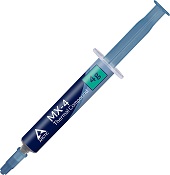What is Thermal paste and why is it absolutely necessary?
Thermal paste, also known as thermal compound or thermal grease, is a viscous substance used in electronics, particularly on computer motherboards and other components, to improve the thermal conductivity between two surfaces. It’s typically used to ensure better heat transfer between a microprocessor (CPU) or graphics processing unit (GPU) and a heatsink or cooler.
Here’s why thermal paste is necessary and how it works:
- Heat Transfer Enhancement: The primary function of thermal paste is to fill in microscopic gaps and imperfections between the two mating surfaces, such as the CPU/GPU and the heatsink. These imperfections can create air pockets that inhibit efficient heat transfer. Thermal paste helps to eliminate these gaps, allowing heat to move more effectively from the heat-producing component to the heatsink.
- Preventing Air Pockets: Even when you clamp a heatsink down onto a CPU/GPU, there can still be microscopic gaps due to surface irregularities. These gaps can trap air, which is a poor conductor of heat. Thermal paste fills these gaps, replacing the air with a material that conducts heat much better, like silicone-based thermal compounds.
- Improved Cooling: Efficient heat transfer is crucial for preventing the CPU/GPU from overheating. When electronic components operate, they generate heat, and if this heat is not dissipated effectively, it can lead to reduced performance, system instability, or even permanent damage. Thermal paste helps by ensuring that as much heat as possible is transferred away from the CPU/GPU to the heatsink, which can then be cooled by a fan or other cooling solution.
- Ease of Application: Thermal paste also serves as a convenient medium to ensure proper contact between the CPU/GPU and the heatsink. It provides a uniform layer, making it easier to install cooling solutions securely and evenly.
Without thermal paste, the interface between the CPU/GPU and heatsink would not be as efficient, and the components could overheat quickly, leading to system instability and potential damage. It’s essential to apply an appropriate amount of thermal paste, typically a small pea-sized or rice-sized drop, to strike the right balance between filling gaps and not applying too much, which can be counterproductive.
Can you reuse old thermal paste?
In most cases, it is not recommended to reuse old thermal paste once it has been applied and then removed. There are several reasons for this:
- Reduced Effectiveness: Thermal paste is designed to create a thin, even layer between the CPU/GPU and the heatsink. Over time, as it’s subjected to heat cycles and pressure, it can change in consistency and become less effective at conducting heat. Reusing old thermal paste may result in reduced thermal conductivity, leading to higher temperatures and potentially reduced system performance.
- Uneven Application: When you remove a heatsink, the old thermal paste often doesn’t come off cleanly. Residual thermal paste or irregularities in the old paste may cause an uneven application when you try to reuse it, further reducing its effectiveness.
- Contaminants: When you remove a heatsink that’s been secured with thermal paste, it’s common for dust, lint, or other contaminants to get mixed into the thermal paste. Reusing thermal paste with contaminants can hinder its ability to create a proper thermal interface and may increase the risk of overheating.
- Convenience and Cost: Thermal paste is relatively inexpensive, and it’s a good practice to use fresh thermal paste when reseating a heatsink. It ensures optimal thermal performance and reduces the risk of issues related to old or contaminated paste.
In general, it’s better to clean off the old thermal paste and apply a fresh layer when reassembling your computer components. There are various methods and cleaning solutions available for removing old thermal paste, such as isopropyl alcohol and lint-free wipes or cotton swabs. Once the old paste is removed and both the CPU/GPU and heatsink are clean, you can apply a new, high-quality thermal paste to ensure efficient heat transfer and proper cooling.
In short
In summary, thermal paste is necessary for improving heat transfer between electronic components and their heatsinks, which is critical for keeping temperatures within safe limits and ensuring the longevity and stability of computer systems.
Secondly, it is not advised to reuse old thermal paste, as they pose a big threat to your device and the paste itself isn’t very expensive in the first place.

